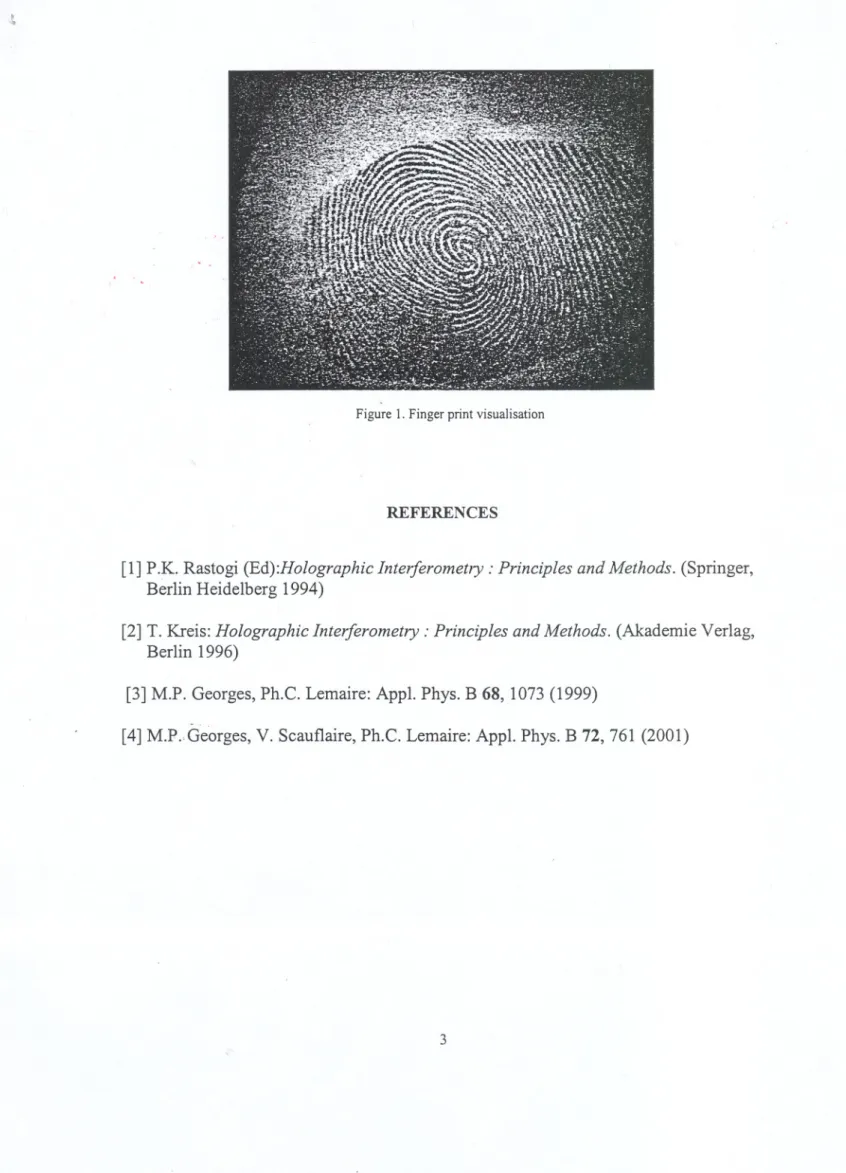J.
Promoptica-Bemeko Study days OPTICS AND INDUSTRIAL VISION, 20-21 January 2004, Louvain-la-Neuve, Belgium
Dynamic holography for fingerprints detection
Philippe C. Lemaire, Marc P. Georges,
Centre Spatial de Liege, Pare Scientifique du Sart Tilman, Avenue du Pre Aily, B-4031 Angleur (Liege), Belgium, ph: 32-4-3676668, fax: 32-4-3675613,plemaire@ulg.ac.be
ABSTRACT
Fingerprint detection method is generally based on optical contrast technique. We present a special case of Holographic Interferometry use, that envisage fingerprint
visualisation on base of their relief Background of the algorithm is first presented and discussed. Wefinish by practical application.
I. INTRODUCTION
Classical methods of Fingerprints (FP) detection are generally based on colour contrast technique. For example, when present on a dark substrate, a white powder is dispersed and trap preferentially by the fingerprint that can be easily visualised. Sometimes this process fail when the substrate is ill-conditioned (badly adapted texture, colour, shape,...). In order to overpass this problem, we propose to consider not only the pattern character of FP but also their relief in order to detect it with Holographic Interferometry (HI). The_Basicschema was simple. A hologram of the object with the FG is taken first. Afterwards the FG is either removed or its relief selectively enhanced. The hologram is then readout and superimposed with the current image of the object. The resulting phase difference in interferograms (ideally n) shows FG pattern. First results obtained, appear promising, but show directly that classical phase algorithm (I, 2) computation don't give reproducible result. Two reasons was possible. First, the relief variation between recording and reading is largely higher than the wavelength and a large number of fringes appear and was not resolved by the imaging system (CCD camera). However study with micro-optical profilometer indicate that FG relief before and after relief enhancement was in the range of wavefront (a few tenth of nanometer). The second reason is the matter difference between the two step. Indeed, either with FP removal or enhancement the observed surface on FP location change (mainly in granularity or texture for the HI purpose) and induce a decorrelation effect that reduce or cancel the interference modulation on FP. As a confirmation, fine analysis of FP part exhibit a largely lower interference modulation than groove between FP.
J
This observation give us the opportunity to use a specific approach for the interferograms processing in order to extract not the phase, as classically, but the modulation obtain during phase-shifting at the readout step. We use a four step technique acquisition of n/2 phase shifted interferograms. By differentiation of interferograms 1 with 3 and 2 with 4 we obtain two images modulated by the sinus and cosinus of phase for each image pixel. The sum of the square of these image eliminate the phase at give an image only proportional to the interference modulation. After normalisation, .the region where FP is present (low modulation) appear dark and inversely the zone between (highly modulated) are white. This process has other .advantage that will appear afterwards.
11. EXPERIMENTS
With regards to proof conservation aspect, we investigate different way to make the FP relief enhancement or texture variation rather than used the FP removal that is the simplest way. A large campaign of tests concerning the enhancement of FP was carried out in order to see which methods gives the best results. It was found that enhancement of FG by cyanoacrylate vapor deposition was the method of choice, because it react well with the high level of water contains in the FP. The holographic set-up use a dynamic holographic photorefractive camera (3, 4). Due to the toxicity of cyanoacrylate, a special vaporisation chamber with evacuation has been used. This process was done outside of the HI setup. Consequently the substrate with the FP is moved between the recording and readout step and it is fixed on special support that allow a good repositioning in front of the camera. During readout regions where substrate is apparent show fringes resulting of the fact that substrate position is not exactly the same than during the recording. But the way of data processing that extract only the interference modulation removed completely this fringes. Figure 1 shows a typical result ofFG visualisation by this technique of HI.
Ill. CONCLUSION
We have show the possibility of fingerprint visualisation by using holographic inteferometry and a specific process for change FP relief and data processing. This latter consist to analyse the interference modulation rather than to compute the phase variation between initial and final status of FP. It give highly contrasted image even in ill condition configuration. An additional interesting feature is the possibility to displace the examined object between recording and reading step. A such procedure is not common in HI and due to the used data processing is without drawback here.
I
...
.
Figure 1.Fingerprintvisualisation
REFERENCES
[1] P.K. Rastogi (Ed):Holographic Interferometry: Principles and Methods. (Springer, Berlin Heidelberg 1994)
[2] T. Kreis: Holographic Interferometry: Principles and Methods. (Akademie Verlag, Berlin 1996)
[3] M.P. Georges, Ph.C. Lemaire: Appl. Phys. B 68, 1073 (1999)
[4] M.P.,Georges, V. Scauflaire, Ph.C. Lemaire: Appl. Phys. B 72, 761 (2001)
